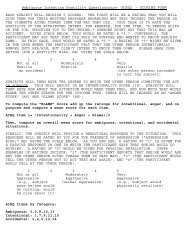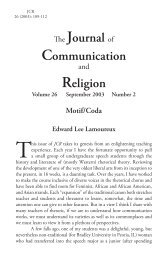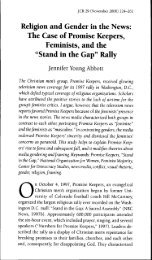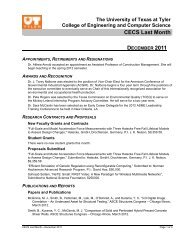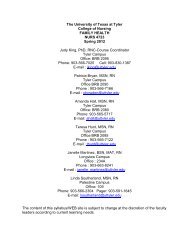"History, Analysis and Performance Considerations of Gerald Finzi's ...
"History, Analysis and Performance Considerations of Gerald Finzi's ...
"History, Analysis and Performance Considerations of Gerald Finzi's ...
Create successful ePaper yourself
Turn your PDF publications into a flip-book with our unique Google optimized e-Paper software.
47Arriving at the word “love” at measure 114, the choir decisively cadences the “Rise”theme in D major while the organ provides three <strong>of</strong> its own final echoes <strong>of</strong> the “sovereignsubject” motive, its own harmonic resolution delayed until the second beat <strong>of</strong> measure 115 (seeFigure 30). The dramatic build-up to the organ’s harmonic arrival in D major is short-livedhowever, as the inclusion <strong>of</strong> C♮ in its scale flourish into measure 116 clarifies the key area as atemporary tonicization only, the entire cadential gesture simply functioning as the dominant <strong>of</strong> Gmajor. The reduction <strong>of</strong> themes h (“Help, Lord”) <strong>and</strong> i (“Rise, Royal Sion”) indicates a subtledownward shift in the background line from B to A, the precursor to the return <strong>of</strong> G in measure116 (see Figure 31).With a return to the initial key <strong>of</strong> “Rise, Royal Sion,” the new celebratory text, “Lo, theBread <strong>of</strong> Life” (theme j) is set with open voicing <strong>and</strong> fanfare-like declamatory rhythms. Thismoment is literally pivotal, the climax <strong>of</strong> the work having been previously reached at “Thissovereign subject,” it is from this point on that the anthem arch begins the return back on itself.While themes i <strong>and</strong> j are not palindromic in a strict thematic sense, they are in so larger aesthetic<strong>and</strong> structural context. Each one celebratory, each a distinct statement <strong>of</strong> praise, each a parallel<strong>of</strong> one another, “Rise, Royal Sion” marks the conclusion <strong>of</strong> the arch-rise, while “Lo, the Bread <strong>of</strong>Life” marks the commencement <strong>of</strong> its descent.As “This sovereign subject” included a strong, two-measure cadential fanfare on theword “love,” so also “This day’s triumphant text” provokes a parallel two-measure organexclamation on the word “praise” at measures 119-120, another indication that the work hasbegun its reverse recapitulation. As examined previously, Finzi’s use <strong>of</strong> changing meter <strong>and</strong>music students are expected in their paperwork to give the correct note values to a few lines <strong>of</strong> verse. This is no badexercise, but there is no greater fallacy than to imagine that a detailed note-for-note accentuation, following the rise<strong>and</strong> fall <strong>of</strong> natural speech, can in itself make good song. Even ordinary recitative can be alive or dead, <strong>and</strong> so toowith syllabic song. Here the composer may be full <strong>of</strong> respect for the poet, but nothing will redeem his setting if ithas not got something beyond that.” Finzi, III.



